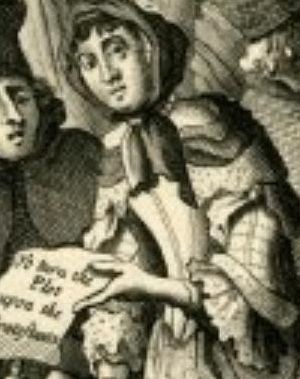Name Elizabeth Cellier | ||
 | ||
Books Malice Defeated ; And, The Matchless Rogue, Elizabeth Cellier | ||
Elizabeth Cellier (commonly known as Mrs. Cellier and dubbed the "Popish Midwife"), flourished 1668–1688, London, England, was a notable Catholic midwife in seventeenth-century England. She stood trial for treason in 1679 for her alleged part in the "Meal-Tub Plot" against the future James II but was acquitted. She later became a pamphleteer and made attempts to advance the field of midwifery.
Contents
Life
Elizabeth Cellier was a noted London midwife, who came into prominence through the pretended "Meal-Tub Plot" of 1680. Nothing seems known of her life until her marriage with Peter Cellier, a Frenchman, and her conversion from Anglicanism.
In 1678 the prisons were filled with Catholics in consequence of the national alarm caused by the fabricated plots of Titus Oates. Mrs. Cellier's charity led her to visit and relieve these prisoners, and as her profession procured for her the acquaintance of many leading Catholic ladies, she often became the channel of their charity towards the prisoners. Among these ladies was the Countess of Powis, whose kindness was shown to, among others, a clever imposter, Thomas Dangerfield. Becoming aware of this man's true character, Lady Powis ceased to assist him further, and he, in revenge, decided to denounce her to the government as concerned in a new Popish Plot.
Dangerfield's story was that he had been released from prison through the good offices of Lady Powis and Mrs. Cellier on condition that he assassinate the king, Lord Shaftesbury, and others. He further pretended that he was to be engaged in manufacturing false plots to be foisted on those who were known to be unfavourable to the Catholic cause. One of these shams was to be based on a document which, he alleged, was hidden in a meal-tub in Mrs. Cellier's house. A search was made, and the paper in question was found in a meal-tub. It charged with treason most of the leading Protestants, including the king's natural son, the Duke of Monmouth, the Earl of Shaftesbury, and Sir Thomas Waller, who was the very official charged with the search. Lady Powis and Mrs. Cellier were arrested, as were some other Catholics, among them the Earl of Castlemaine.
Mrs. Cellier's trial took place on 11 June 1680. She was charged with high treason, but practically the only evidence against her was that of Dangerfield himself, and she had little difficulty in proving him a witness entirely unworthy of credence. She was found not guilty, and Dangerfield himself was arrested on account of a felony, for which he had been previously outlawed. After her acquittal, she published a brief relation of the whole affair, under the title of "Malice Defeated" in 1680. Dangerfield, while undergoing a public whipping in 1685, was accidentally killed in a scuffle with a barrister, Robert Francis.
The publication of Malice Defeated led not only to a long series of pamphlets for and against her, but also to her second prosecution. The charge this time was that of libel against the king and ministry, because she alleged that two witnesses in the Edmund Berry Godfrey case had been tortured. The real object of this prosecution, according to Roger North, was to prevent her from giving evidence in favour of the imprisoned Catholic peers. For this, she was sentenced to pay a fine of £1,000 and to stand three times in the pillory.
During the reign of James II, she proposed the foundation of a corporation of skilled midwives and a foundling hospital. The fees would be used to set up parish houses where any woman could give birth. It is stated that she is buried in Great Missenden Church, Buckinghamshire.
Works
She wrote:
